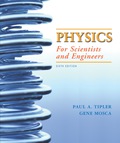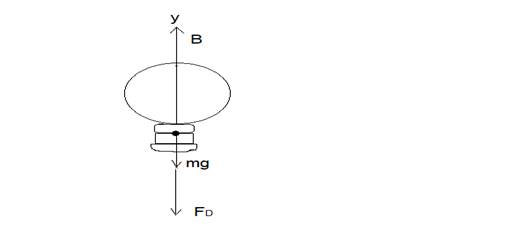
Concept explainers
(a)
The initial upward acceleration of the balloon when it is released from sea level.
(a)
Answer to Problem 52P
Explanation of Solution
Given:
Radius of the balloon
Total mass (mass of the balloon + mass of the helium + mass of the equipment)
Formula used:

FIGURE: 1
In the figure 1,
Let us apply the Newton’s second law, that is
Using Archimedes principle, buoyant force
Applying
Since balloon is in spherical shape, volume of the balloon is,
And hence, buoyant force,
Where,
Substituting for buoyant force in equation
Calculation:
Substituting the numerical values in equation
Conclusion:
The initial upward acceleration of the balloon when it is released from sea level is
(b)
The terminal velocity of the ascending balloon.
(b)
Answer to Problem 52P
Explanation of Solution
Given:
Radius of the balloon
Total mass (mass of the balloon + mass of the helium + mass of the equipment)
Drag force of the balloon is
Where,
Formula used:
Let
Let us apply the Newton’s second law, which is
Substituting for
Calculation:
Substituting the numerical values in equation
Conclusion:
The terminal velocity of the ascending balloon is
Want to see more full solutions like this?
Chapter 13 Solutions
Physics for Scientists and Engineers
- What do vectors and scalars have in common? How do they differ?arrow_forwardIn building a house, carpenters use nails from a large box. The box is suspended from a spring twice dining the day to measure the usage of nails. At the beginning of the day, the spring stretches 50 cm. At the end of the day, the spring stretches 30 cm. What fraction or percentages of the nails have been used?arrow_forwardThe weight of bodies my change somewhat from one location to another as a result of the variation of the gravitational acceleration g with elevation. At 45° latitude, the gravitational acceleration as a function of elevation 'z' above sea level is given by; g = a – bz ,where a = 9.8066 and b = 3.32 × 10-6s². Determine the weight (in Ib;) of an 160-lbm person at sea level (z = 0), in Denver (z = 1610 m) and on top of Mount Everest (z = 8848 m). %3Darrow_forward
- An airplane in flight is subject to an air resistanceforce proportional to the square of its speed v. But there is an additionalresistive force because the airplane has wings. Air flowing over thewings is pushed down and slightly forward, so from Newton’s third lawthe air exerts a force on the wings and airplane that is up and slightlybackward (Fig.). The upward force is the lift force that keeps theairplane aloft, and the backward force is called induced drag. At flyingspeeds, induced drag is inversely proportional to v2, so the total airresistance force can be expressed by Fair = av2 + b/v2, where a andb are positive constants that depend on the shape and size of the airplaneand the density of the air. For a Cessna 150, a small single-engineairplane, a = 0.30 N . s2/m2 and b = 3.5 * 105 N . m2/s2. In steadyflight, the engine must provide a forward force that exactly balances theair resistance force. (a) Calculate the speed 1in km>h2 at which this airplanewill have the maximum…arrow_forwardA 50.0 kg box is being pushed along a level floor with a force of 440N. If the coefficient of kinetic friction is uk = 0.25, what the accleration of the box?arrow_forward7. The effects of atmospheric drag cannot be deglected, in general, on the dynamics of objects moving through the air. The drag force is found to be FD where p is the density of air, A is the cross sectional area of the object, v is the object's velocity, and Cp is the so called drag coefficient. For a baseball Cp is measured to be - .5ρA Cp υ?, .3. (a) If the baseball is launched vertically with a speed of 90 miles per hour, how high will it travel? How would the answer change ignoring air resistance? (b) What is the speed of the baseball when it comes back down? How would the answer change if there was no air resistance? (c) How long does it take for the baseball to go up? Down? How would the anwers change in the absence of air resistance?arrow_forward
- A) If u between A and B is 0.3 and between B and floor is 0.25, find the value of F required to pull block B shown in Fig. (2). Take mass of A = 40 kg and B = 60 kg. %3D %3D 30° В Fig. 2arrow_forwardA small boat is being pushed up a ramp into the back of a flatbed truck. The boat is sitting at the top of the ramp, which is located 1.4 m above the ground. The boaters think the boat is safe there, and begin to walkaway. However, they have neglected the thin layer of ice that has formed on the ramp, which is angled at 30◦ up from the ground. Neglecting the friction between the boat and the ramp, how long do the boaters havebefore the boat reaches the bottom of the ramp?arrow_forwardOur 10kg mystery box rests on a horizontal floor. The coefficient of static friction is 0.40and the coefficient kinetic friction is 0.30. Determine tge force of friction, acting on the box if a horizontal applied force is exerted on it of magnitude: (d) 38N, and (e) 40N. Use 9.81m/s squared for the gravity while F sub A for the unit of applied forcearrow_forward
- he mass of a sports car is 1400 kg. The shape of the car is such that the aerodynamic drag coefficient is 0.260 and the frontal area is 2.30 m². Neglecting all other sources of friction, calculate the nitial acceleration of the car, if it has been traveling at 115 km/h and is now shifted into neutral and is allowed to coast. (Take the density of air to be 1.295 kg/m³) your response differs from the correct answer by more than 10%, Double check your calculations. m/s² Need Help? Readarrow_forward(a) A sphere made of wood has a density of 0.810 g/cm3 and a radius of 7.50 cm. It falls through air of density 1.20 kg/m3 and has a drag coefficient of 0.500. What is its terminal speed (in m/s)? m/s (b) From what height (in m) would the sphere have to be dropped to reach this speed if it fell without air resistance? Read It Need Help?arrow_forwardThe force acting on a particle has a magnitude of 114 N ane is directed 27.8° above the positive x-axis. (a) Determine the x-component of the force. (b) Determine the y-compenent of the force. Need Help? Read Itarrow_forward
 Principles of Physics: A Calculus-Based TextPhysicsISBN:9781133104261Author:Raymond A. Serway, John W. JewettPublisher:Cengage Learning
Principles of Physics: A Calculus-Based TextPhysicsISBN:9781133104261Author:Raymond A. Serway, John W. JewettPublisher:Cengage Learning University Physics Volume 1PhysicsISBN:9781938168277Author:William Moebs, Samuel J. Ling, Jeff SannyPublisher:OpenStax - Rice University
University Physics Volume 1PhysicsISBN:9781938168277Author:William Moebs, Samuel J. Ling, Jeff SannyPublisher:OpenStax - Rice University

